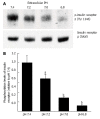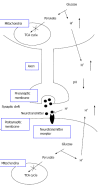Roles of interstitial fluid pH in diabetes mellitus: Glycolysis and mitochondrial function
- PMID: 25685283
- PMCID: PMC4317304
- DOI: 10.4239/wjd.v6.i1.125
Roles of interstitial fluid pH in diabetes mellitus: Glycolysis and mitochondrial function
Abstract
The pH of body fluids is one the most important key factors regulating various cell function such as enzyme activity and protein-protein interaction via modification of its binding affinity. Therefore, to keep cell function normal, the pH of body fluids is maintained constant by various systems. Insulin resistance is one of the most important, serious factors making the body condition worse in diabetes mellitus. I have recently found that the pH of body (interstitial) fluids is lower in diabetes mellitus than that in non-diabetic control, and that the lowered pH is one of the causes producing insulin resistance. In this review article, I introduce importance of body (interstitial) fluid pH in regulation of body function, evidence on abnormal regulation of body fluid pH in diabetes mellitus, and relationship between the body fluid pH and insulin resistance. Further, this review proposes perspective therapies on the basis of regulation of body fluid pH including propolis (honeybee product) diet.
Keywords: Binding affinity to receptors; Insulin; Interstitial fluid; Propolis; pH.
Figures








References
-
- Cederholm J, Wibell L. Glucose intolerance in middle-aged subjects--a cause of hypertension? Acta Med Scand. 1985;217:363–371. - PubMed
-
- Eriksson KF, Lindgärde F. Contribution of estimated insulin resistance and glucose intolerance to essential hypertension. J Intern Med Suppl. 1991;735:75–83. - PubMed
-
- Bao W, Srinivasan SR, Berenson GS. Persistent elevation of plasma insulin levels is associated with increased cardiovascular risk in children and young adults. The Bogalusa Heart Study. Circulation. 1996;93:54–59. - PubMed
-
- Haffner SM, Ferrannini E, Hazuda HP, Stern MP. Clustering of cardiovascular risk factors in confirmed prehypertensive individuals. Hypertension. 1992;20:38–45. - PubMed
-
- Marunaka Y, Hagiwara N, Tohda H. Insulin activates single amiloride-blockable Na channels in a distal nephron cell line (A6) Am J Physiol. 1992;263:F392–F400. - PubMed
Publication types
LinkOut - more resources
Full Text Sources
Other Literature Sources

